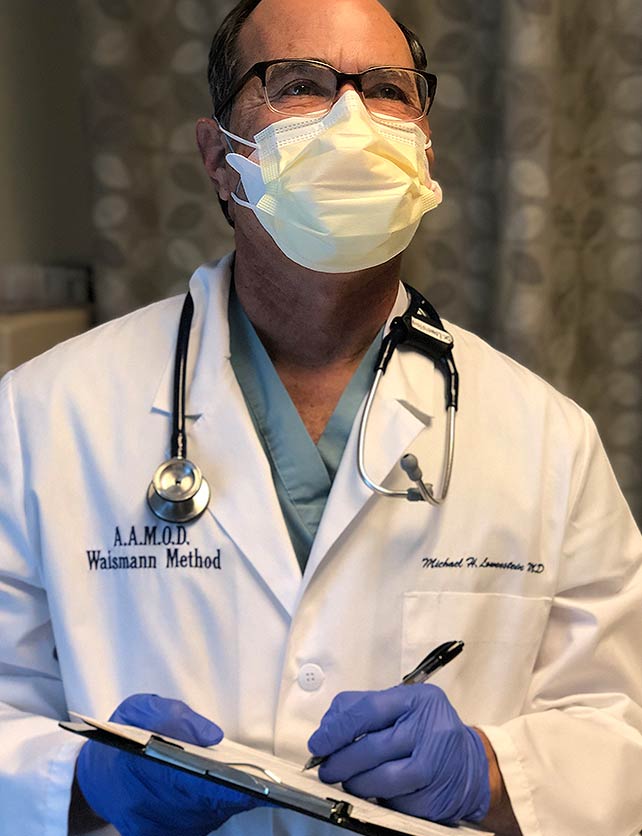Numerous drug treatment centers claim to offer rapid detoxification, but most of them do not actually provide detoxification under anesthesia. Responsible rapid detox centers offer significantly higher levels of medical care than non-hospital detoxification programs or rehabs can provide. Knowing the differences between opioid detox providers can help you find the proper treatment for you. Look for the following red flags before making your decision.
8 Ways to Tell a Trustworthy Rapid Detox Center from the Rest
Knowing what to expect when you choose a rapid detox treatment is essential for several reasons. First, if you know what to expect and receive what was promised, you will not be disappointed or feel misled. Thus, the chances of a more effortless and successful treatment are much higher.
As you research rapid detox centers, look carefully for differences in their descriptions. These points can help you think of questions you might want to ask about the facility, physicians, treatment, or anything you don’t understand.
Choosing the Best Rapid Detox Center
- Accreditation
- Level of individualized care
- Services provided or available in case of immediate need
Evaluate the photos of the treatment facility. You might find side-by-side beds and a lack of medical equipment indicating the facility is not a hospital. A proper ICU treating room has electrical, gas, and various other medical equipment mounted onto the wall beside the head of the patient’s bed. Those resources are immediately available during anesthesia detox.
For over 26 years, people from all over the world have chosen Waismann Method as their opioid detox provider.
We know the challenges you face and the importance of creating a unique and personal experience for you right from the start.Call for Detox Options 1-800-423-2482
Learn about the physician who would be treating you by asking the right questions:
- How much experience does the treating physician have with anesthesia detox?
- Is the doctor board-certified?
- Are his/her credentials from well-known organizations?
- Does he/she offer multiple protocol options to accommodate each patient’s health needs? Or are the patients all offered a single detoxification method regardless of their individual needs?
Read the website’s description of what the detoxification treatment really consists of. Look for claims on the website that sound ‘too good to be true,’ such as “painless,” “cure,” and “unlimited care.” Those promises are impossible to keep in most cases, and especially in all cases.
Here are more examples of what to look for to tell safe, rapid detox procedures apart from others:
1. ‘Three Days’ or ’48 Hours’ Is Not Rapid
Rapid detox is a procedure created to allow doctors to speed the withdrawal syndrome while patients are under anesthesia. The procedure has evolved into a much safer, faster, and reliable technique throughout the decades than its original form.
Proper rapid detox occurs while the patient is under sedation for approximately two hours or less. Any other time frame — such as 24 hours, 48 hours, or three days — should not be referred to as rapid detox but rather a “faster detox.”
2. Outpatient Accelerated Detox Is Not Rapid Detox
Most websites that claim to offer “48-hour detox” or “accelerated opiate detox” do not provide rapid detox. They also do not provide inpatient hospital care. Instead, they may offer outpatient detox assistance with medication. The withdrawal period is not shortened in this “accelerated” method so it’s not a rapid detox treatment. Patients are also not sleeping under anesthesia through the acute withdrawal phase.
Providers of outpatient accelerated detox often give patients medications to flush a patient’s system of opioids and shorten the withdrawal syndrome. In general terms, this process might sound similar to rapid detox, but there are significant differences. These centers have patients in hotel rooms with family members during a very stressful and unstable time — one that can lead the patient to erratic mood swings, actions, and consequences. Although this process is much cheaper than the real rapid detox, it offers substantially less medical care and professional management. Ultimately, it creates more possibilities for failure.
3. Safe Rapid Detox Occurs in a Private ICU of an Accredited Hospital
Although different rapid detox approaches might work for some patients, they also present risks to others. For example, a patient can be exposed to unnecessary discomfort and severe health risks when this kind of treatment is performed under the following circumstances:
- In a facility lacking the resources of an accredited, full-service hospital
- By inexperienced staff members
- On numerous patients at the same time or in the same room
Facilities such as outpatient surgical centers or multiple-patient recovery rooms do not have medical equipment, medications, or medical specialists that accredited hospitals have. Some of these resources come in handy for additional evaluation or in an emergency when immediately available resources can make a difference.
Many sub-par detox centers treat patients side by side in the same room. Although this practice might reduce costs, patients do not receive staff members’ undivided attention, which is vital throughout rapid detox.
Additionally, having strangers going through their own emotional and physical difficulties by your side can significantly elevate your level of stress. You don’t share a room with a stranger when you go to your cardiologist, and you should not share one through anesthesia detox either. Patients benefit from privacy, focused attention from the medical staff, and a calm environment throughout an already stressful time.
The best rapid detox centers treat each patient in a private ICU room of a hospital. In an ICU, a medical doctor performs the treatment with full access to the hospital’s highest level of resources. In addition, each room has medical equipment installed to provide the support needed throughout detoxification under anesthesia. This comprehensive monitoring ensures the patient’s well-being before, during, and after treatment.
4. Rapid Detox Cost Reflects the Level of Care
The difference in facility type, level of care, length of inpatient time, and amount of services provided is evident in the cost of rapid detox. Rapid detox in a full-service, accredited hospital is more costly because it includes a much higher level of medical care.
At an accredited hospital, patients have immediate access to many more medical resources and recourse. In addition, there is no limitation on the length of stay like there is at a surgical center. Instead, patients discharge from the hospital based on their physical readiness, not at preset times that are often too early. These factors offer the peace of mind that comes with being treated according to much higher standards.
To evaluate the cost of treatment, you need to consider what you are receiving. When you pay more for higher-value care from the beginning, you save money by avoiding the costlier consequences of substandard care.
5. General Anesthesia Is Not Necessary for Updated Rapid Detox Protocols
Detox under general anesthesia has become obsolete. It was first used when the procedure started, but safer, shorter, and more evolved protocols have been available for over ten years. Unfortunately, if a treatment provider uses general anesthesia, they are still using archaic, outdated protocols of rapid detox.
Current rapid detox protocols have evolved into much more comfortable, safe, and effective versions that only require sedation for under two hours. They involve using the same type of sedation as you would get for a colonoscopy or having a more involved dental procedure.
6. Cookie Cutter Rapid Detox Treatments

Michael H. Lowenstein, MPH, M.D. – Rapid Detox Physician and Waismann Method® Medical Director. Some rapid detox centers treat patients side by side in a facility, which presents risks to patients. Waismann Method® only treats patients one at a time in the privacy of a private ICU room in a full-service, accredited hospital.
Many rapid detox centers offer one single treatment method to all patients. Unfortunately, this cookie-cutter approach attempts to fit every person into a single treatment plan, leading doctors to treat patients who are not the ideal candidates for detoxification under anesthesia.
One of the many things that set the Waismann Treatment™ apart is that patients don’t have to adapt to the treatment. Instead, the Waismann Method® medical director will adjust the treatment to each patient’s health needs.
Being treated individually in a full-service, accredited hospital allows for modifications to the detox protocol, immediate medical assistance, and flexibility regarding the length of treatment.
From the initial comprehensive medical evaluation to the completion of the rapid detox, the Waismann Detox™ medical director, Dr. Michael H. Lowenstein, and the medical staff are monitoring the patient’s well-being and adjusting treatment as necessary.
7. If It Sounds Too Good to Be True, It Usually Is
There is no such thing as “painless” detox. Therefore, any detox center claiming to offer “painless” rapid detox is probably not providing accurate information.
There also is no such thing as a single miracle “cure” for opioid use disorder. Humans are complex beings, and treatment involves multiple factors, but there are more effective treatments than others.
Rapid detox is a highly successful treatment for reversing a patient’s physical opioid dependence. Because the treatment reduces the discomfort and duration of acute withdrawal, it enables patients to complete the detox phase successfully and move on to adequate emotional support or other forms of physical or psychological therapy.
Read: Why Does Rapid Detox Work So Well?
Rapid detox is a medical treatment for a physiological condition. This successful detoxification does not specifically treat addiction because is a behavioral issue. However, it certainly gives patients the best foundation to begin treating any underlying emotional issues. Therefore, any provider claiming to end opioid addiction quickly is not providing an accurate depiction of effective treatment. Moreover, it could mean that the “professionals” involved do not clearly understand the difference of the condition they are claiming to treat — physical dependence or addiction.
The best rapid detox centers provide straight talk and accurate information. They factor in your medical history, opioid use, and personal needs to determine what kind of treatment and length of stay you’ll likely need to complete detox safely and successfully.
8. If It’s Not in Southern California, It’s Not Waismann Method®
Waismann Method® is one of the originators of rapid detox and has contributed to significant, pioneering efforts to make safe and effective medical protocols for treating opioid use disorder. The Waismann Treatment™ has maintained the highest opioid detox success rate in the U.S. for over 20 years because it has remained a boutique facility with carefully controlled parameters.
The only location where you can receive the Waismann Method® treatment worldwide is in Southern California. Through the last two decades, thousands of patients have flown from all over the world to California to undergo this treatment. Waismann Method® does not train other doctors or partner with other facilities anywhere in the world to offer any medical detox or rapid detox treatment.
Because of Waismann Method®’s success, many professionals claim to offer the same treatment or claim affiliation with Waismann. However, it is critical to know that other detox centers offer alternative detox treatments that do not meet Waismann Method®’s safety standards. The Waismann Method® team has concentrated all of its efforts in Southern California for over two decades to provide the best rapid detox in the world and continue to do so.






